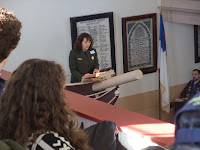This year's Moby-Dick Marathon (MDM17, Jan. 4-6) was a close duplicate of
last year's MDM. The crowd seemed slightly smaller than the record-breaker of 2012; the readers, on average, seemed a bit less eloquent. It was great to see my Marathon pals again, but my blog-mates were no-shows and several "regulars" were mysteriously absent. (Also, the photo-ops are becoming boringly
predictable.)
As always, the weekend's events ran like clockwork. Thanks go to the museum's Science Director, Robert Rocha, the rest of the museum staff, and the dedicated volunteers.
If you have a "bucket-list," the MDM should be on it.
I drove to New Bedford with Dutch MDM veterans,
Tjitske and Tonnie. Following tradition, we hastily checked-in at our hotel and toddled off to what Lemuel calls "
the Marathoner's Rest" to toast our happy return to The Whaling City. All agreed, it felt great to be back.
 |
| Matt Kish at the podium |
MDM17 kicked-off Friday evening with a talk by graphic artist and librarian,
Matt Kish. He described his artistic odyssey, creating a drawing-a-day for every page in his
Signet Classic edition of M-D; 552 pages, 552 pieces of original art.
As he worked, he didn't count the pages; he didn't look ahead. (He didn't quit his day job!) He conceived and executed one drawing every day for over a year and a half. (Like the MDM itself, there's an element of performance art here.)
What started as a personal goal became a
blog. Then the blog became a splendidly realized
book.
He described the process as "months of obsessive misery." So he's obsessive (appropriate to his subject). He's also very articulate, open, and... modest.
Matt's emotional, non-academic interaction with M-D was refreshing. It dawned on me that M-D is a rich and multi-faceted book that accommodates any number of approaches. "In my father's house there are many mansions" comes to mind.
Saturday morning brought the third annual "Stump the Scholars." This year's teams were the Clams — Wyn Kelley (M.I.T), Matt Kish ("I'm not a scholar!"), Robert Wallace (Univ. of Kentucky)
vs the Cods — Jennifer Baker (NYU), Tim Marr (Univ. of North Carolina), Mary K. Bercaw Edwards (Univ. of Connecticut). Before the questions started, Wyn Kelley announced that Peter Whittemore (Melville's great-great grandson) would not be attending this year's MDM. [All the best to you, Peter. You were missed.]
The contest was again entertainingly moderated by the museum's Maritime Curator, Michael Dyer. This year's crop of questions stimulated a lot of discussion, even among audience members; e.g. Moby Dick is male, so why is the cry always "there
she blows?" No one had a conclusive answer.
In a break with tradition, "Stump" did
not end in a tie! ...but I don't remember which team won.
Then it was into the museum proper to begin the reading. This year, the museum asked for a $5 donation for an MDM button. This was certainly understandable in light of the
withdrawal of a grant from the Dept. of Education. There were (reasonable) charges for food and drink, too, which is fair enough, but I really missed seeing the
ministering angels of the chowder line of years past.
A small but significant improvement greeted us in the Lagoda Room. As last year,
Extracts were read by some of the Scholars, but this year they were read at the
microphone. The MDM never stops evolving!
At noon, Museum President James Russell called for "eight bells," and we were off.
Lemuel terms these opening hours of the MDM "
The Pageant," and they can be a little tedious. The text is often comic, the celebrity readers can be uninspired, and the green hands in the audience insist on applauding after every reader (breaking the flow,
grumble, grumble...).
Still, it's a beautiful setting on a sunny winter afternoon; great people-watching — students and old duffers, couples and young families; perched on the model ship and ranging along the upper balcony, silently bent over some book.
 |
| Jennifer Nersesian of the NBWNHP |
As Chapter 7 approached, marathoners in the know nervously crowded the side door so as to be at the head of the line for the Seamen's Bethel. Inside the Bethel (standing-room only) the first reader was Jennifer Nersesian, the Superintendent of the
New Bedford Whaling National Historical Park. She reads each year in her Park uniform, and is always outstanding.
To be continued...























